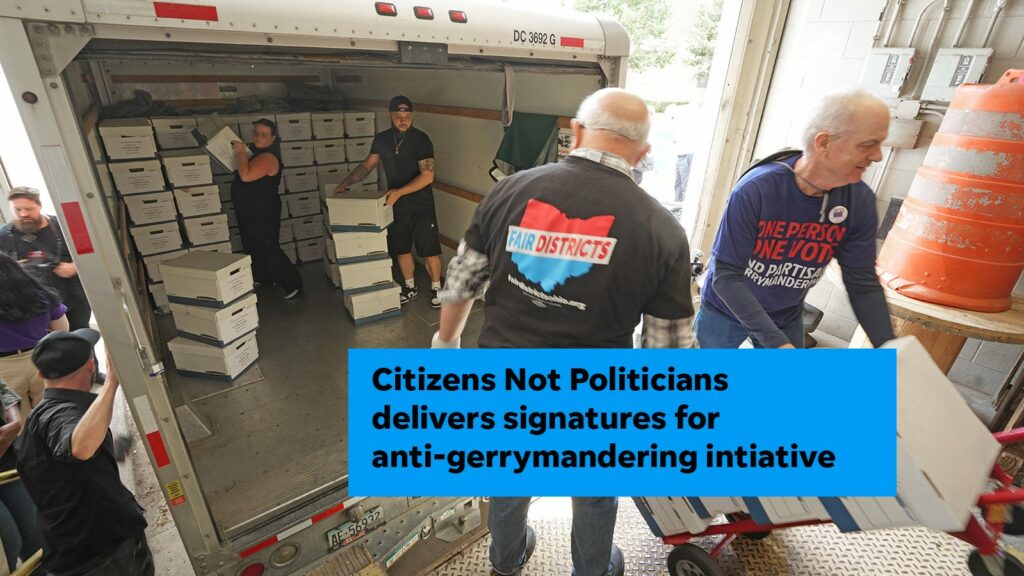‘We’re done listening to self-serving politicians tell us how they want to keep rigging the game,’ former Ohio Chief Justice Maureen O’Connor said of DeWine’s campaign against the ballot issue

Citizens Not Politicians delivers signatures for ballot initiative
Citizens Not Politicians delivers signatures for anti-gerrymandering initiative in Ohio. With 731,000 signatures, supporters expect it on the ballot
Ohio and Iowa share an interest in everything from corn and soybeans to Big Ten football and Midwest jargon. But should they share a redistricting model for drawing congressional and state legislative maps?
Ohio Gov. Mike DeWine wants voters to reject a new proposal on the November ballot to replace politician mapmakers with a 15-member citizen redistricting commission. Instead, the Republican governor asked lawmakers to adopt the Iowa model.
However, the ballot campaign, Citizens Not Politicians, says Ohio isn’t Iowa. The Buckeye State has more than 3.5 times the population, includes several more large cities, is home to 12 times more Black residents and is not roughly shaped like a rectangle with counties laid out on a grid.
Geography and demographics aside, Ohio Republicans are more intent on gerrymandering maps to benefit their candidates than their Iowa counterparts, backers of the proposed amendment said.
“Gov. DeWine voted with his fellow politicians seven times for unconstitutional maps, and now says what Ohio really needs is what he calls ‘The Iowa Plan,’ a system where the governor and other politicians get the final say on maps,” said former Ohio Supreme Court Chief Justice Maureen O’Connor, a Republican who helped craft the citizen redistricting plan on the ballot. “We’re done listening to self-serving politicians tell us how they want to keep rigging the game.”
What is the Iowa model?
How does Iowa draw maps? Iowa’s Legislative Services Agency, a nonpartisan group tasked with analyzing proposed laws’ legal and financial impact, draws maps for Congress and the state Legislature using criteria detailed in state law.
A five-person commission, four of whom are selected by top Republicans and Democrats in the Legislature, offers guidance to the LSA on crafting maps. Under Iowa law, mapmakers cannot consider where sitting lawmakers live or political data like how many Republicans are in an area. They cannot draw districts to favor a party, an incumbent or a candidate.
After LSA draws the maps, the Iowa Legislature must approve or reject them. Republicans hold a majority in both chambers and a veto-proof majority in the Iowa Senate. (In Ohio, the GOP has a supermajority in both legislative chambers.)
If lawmakers reject the maps, the Iowa LSA crafts new ones to address legislators’ concerns. If the Iowa Legislature rejects three maps, lawmakers can take over the process and craft their own. But Iowa lawmakers have never done that since the model’s inception in 1980. The governor, currently Republican Kim Reynolds, must sign into law any approved maps.
The current Iowa congressional map includes two districts that favor Republicans and two competitive seats. That ratio is in line with the state’s voters, who picked former President Donald Trump over President Joe Biden, 54-45%, in 2020.
“We have a model that has worked in Iowa since about 1980,” said Terese Grant, co-president of the League of Women Voters of Iowa. “That’s not to say this is a process that would work everywhere.”
Iowa lawmakers haven’t been tempted to reject LSA’s maps to craft their own. “If they would reject it (the map), I think there would be such an outcry in this state that they don’t want to go there.”
Would the Iowa model work in Ohio?
DeWine says Iowa’s model can work in Ohio.
“The only way to do this is to take politics completely out of the drawing of the maps,” said DeWine, pointing to Iowa’s criteria to ignore political data. “Ohio should have a constitutional provision that instructs mapmakers that they cannot consider past voting data that the mapmakers know will lead to a predetermined partisan outcome.”
But Iowa’s model keeps politicians involved in the redistricting process − something DeWine has said he wants to do away with. When asked about that, DeWine said he’s open to someone else drawing the maps or approving them.
“Who draws it, bluntly, is not nearly as important as the criteria that would be in the Constitution that they have to follow whomever that mapmaker is,” DeWine said.
But backers of the Ohio redistricting reform measure say it’s laughable to assume Ohio politicians would exhibit the same restraint that Iowan lawmakers have. Ohio’s Republican-dominated mapmaking commission missed deadlines, ignored Ohio Supreme Court orders and approved multiple maps without the backing of Democrats on the panel.
“Gerrymandering does not happen equally everywhere,” said Yurij Rudensky, a deputy director of the Democracy Program at the Brennan Center for Justice, which supports the Ohio amendment. “The bottom line is the Iowa model, which maintains the ability of the Legislature to do what it wants and for the governor to stay involved in redistricting, would be a terrible fit for a state like Ohio, which has been one of the most gerrymandered in the country for decades.”
Jessie Balmert is a reporter for the USA TODAY Network Ohio Bureau, which serves the Columbus Dispatch, Cincinnati Enquirer, Akron Beacon Journal and 18 other affiliated news organizations across Ohio.
Source link : http://www.bing.com/news/apiclick.aspx?ref=FexRss&aid=&tid=66b43560eed748a2b2f2c007c1b743a3&url=https%3A%2F%2Fwww.dispatch.com%2Fstory%2Fnews%2Fpolitics%2F2024%2F08%2F07%2Fwould-iowas-redistricting-model-work-in-ohio-gov-mike-dewine-citizens-not-politicians%2F74630119007%2F&c=13307283940864849596&mkt=en-us
Author :
Publish date : 2024-08-07 15:02:00
Copyright for syndicated content belongs to the linked Source.
